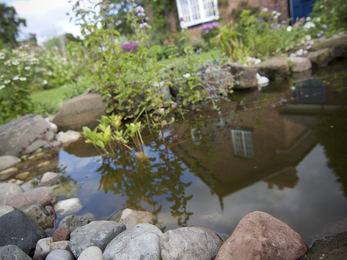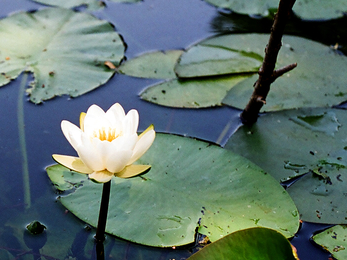By Kathryn Shatford
Avon Wildlife Trust communications volunteer
A whole host of wildlife depends on ponds for feeding, breeding, drinking and sheltering. Because of pollution, development and intensive farming, many of our ponds, streams and rivers have been lost or damaged. Suitable freshwater habitats are now scarcer and more fragmented than ever before, meaning the wildlife which depends on them can’t move to new water in search of food and breeding grounds, so their populations decline. Garden ponds are therefore a vital resource, acting as stepping stones between larger areas of water and are one of the most wildlife-rich habitats you can create at home.
Almost immediately after adding a garden pond you may notice a gentle buzz of wildlife around the water. In just two weeks you may see birds bathing, hedgehogs stopping for a drink, water boatmen and pond skaters exploring the water and dragonflies looking for somewhere to lay their eggs. In spring, you may see amphibians like frogs and toads and their unusual-looking spawn. During summer dusks, you could spot bats darting over the water, feeding on the insects the pond has attracted.
While larger, dug-out ponds attract the highest number of species, don’t underestimate how helpful a smaller, more makeshift pond can be. An old bathtub, sink, paddling pool or even just a washing up bowl can provide pitstops for aquatic insects and amphibians. You just need to provide a ‘frog ladder,’ made from stones or wood either side of the container’s wall so that amphibians can climb in and out. Add a few rocks and pond plants to provide oxygen and shelter for aquatic larvae and other young creatures like tadpoles.
Ideally your pond should have both deeper and shallower areas. Surprisingly, sections with depths of just one to ten centimetres are the most wildlife-rich parts of the whole pond! Shallower areas are also important for many young creatures like tadpoles, as the water quickly warms up during spring. During winter, frogs and toads bury themselves in silt at the bottom of deeper areas, breathing through their skin. Include rocks in both the shallower and deeper parts to provide extra shelter for pond wildlife. You may notice tadpoles sucking algae off them too!
Try to incorporate a mixture of different types of pond plants. Underwater plants, for example marsh marigold, add oxygen to the water and are used by toads, who wrap their string-like spawn around their stems. Emergent plants are rooted in the pond but jut out of the water. They are helpful to dragonfly nymphs, which climb up the rigid stems before turning into winged adults. Floating plants such as water lilies act as landing pads for thirsty insects, like bees, as they stop for a drink. Frogs can sit on them to catch insects whilst tadpoles and dragonfly larvae shelter beneath them. During their flowering period they’ll attract a range of pollinating insects.
As well as the pond, there are things you can do to the surroundings to support wildlife. Many plants can grow in the damper soils around pond borders, for example marsh woundwort and great burnet. They can be planted to provide shade, shelter, food and breeding grounds for aquatic and semi-aquatic wildlife and their flowers attract pollinating insects during spring and summer. Keep grass around the pond long to offer protection to young frogs, toads and newts from predators. Rock piles can be dotted around the pond edges for extra shelter. If possible, make the pond sides gently sloping to help amphibians enter and exit the pond and hedgehogs to drink safely without risking falling and getting stuck.
In Britain, our gardens and outdoor spaces cover more land than all our nature reserves put together and offer us an opportunity to create our own mini nature reserves. If everyone adds a pond or watery pitstop, we can create a wildlife-rich network of waterbodies across the country for insects, amphibians, mammals and birds to thrive in and move safely between.
Look at our step by step guide on creating your own wonderful wildlife pond
Photo credits: Ian Wade; Zsuzsanna Bird



